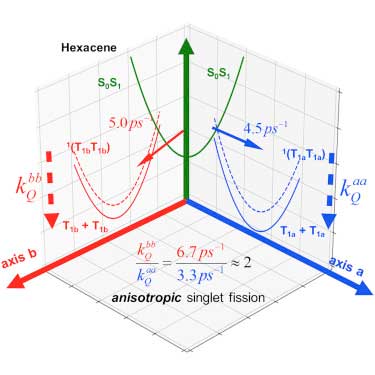| Sep 28, 2019 | |
Researchers unveil the dynamic nature of single fission(Nanowerk News) Chemists from the College of Science at Utah State University have unveiled the dynamic nature of single fission, a novel photophysical phenomenon that bears an unprecedented potential to drastically improve the solar cell efficiency. |
|
| In collaboration with researchers from Columbia University, George Washington University (GWU) and Honda Research Institute USA (HRI-US), the USU scientists jointly published their findings on iScience ("Anisotropic Singlet Fission in Single Crystalline Hexacene"). The research endeavor carried out at USU was funded by HRI-US that supports Prof. Rao Yi, the leading corresponding author of the iScience paper. The other two corresponding authors are Prof. Hanning Chen of George Washington University, and Dr. Gugang Chen of HRI-US. | |
 |
|
| Graphical abstract shows 3D rendering of singlet fission. (© Cell Press) | |
| “The energy conversion efficiency of conventional solar cells, such as silicon panels, is capped at 34%. This so-called Shockley-Queisser limit was derived under the assumption of single electron-hole pair generation upon the absorption of a photon from solar light” says the leading PI, Dr. Rao, an assistant professor of the Department of Chemistry and Biochemistry. “In that regard, singlet-fission materials that enable the generation of multiple electron-hole pairs can readily circumvent the long-standing Shockley-Queisser limit by minimizing thermalization loss. A deeper understanding of singlet fission is highly desired for the pursuit of more efficient and more versatile materials for the next-generation solar cells." | |
| The Chief Scientist Dr. Avetik R. Harutyunyan and Senior Scientist Dr. Gugang Chen from HRI-US initiated and designed this research. “Eco-friendly technologies especially disruptive innovations for the exploitation of renewable energy sources are always of central importance for our research. We have carefully monitored the progress in multiple exciton generation, the analogue of singlet fission in semiconductors, after its first experimental observation in 2004. Shortly after Dr. Chen jointed my group, we had since lunched collaborations with Columbia University and others. These collaborations led to fruitful publications including in Nano Letters ("Observation of Rapid Exciton–Exciton Annihilation in Monolayer Molybdenum Disulfide") and Nature Chemistry ("Coherent ultrafast lattice-directed reaction dynamics of triiodide anion photodissociation") that we believe evoked good interest among peers” mentioned Dr. Harutyunyan, one of the coauthors of the paper. “By identifying the intermediate species in the process of singlet fission and monitoring their temporal evolutions in sub-ps time scale, you are capable of extracting the picture about how singlet fission takes place in such a material. That information will guide our design of new materials with higher solar efficiency, another crucial step towards a new generation of solar cells,” said Dr. Gugang Chen. | |
| Dr. Rao led the team for the development of polarized transient absorption microscope, which has been utilized to measure how fast the triplet carriers in hexacence single crystals are formed under the light excitation. The experimental observations have been supported by theoretical calculations led by Dr. Hanning Chen. The efficacious collaborations between experimentalists and theoreticians are also exemplified by their recent Journal of Chemical Physics article ("Vibronic fingerprint of singlet fission in hexacene") about vibronic fingerprint of singlet fission in hexacene, a project that was partially funded by HRI-US, too. | |
| In their iScience article, the researchers concluded that anisotropic singlet fission in single crystalline hexacene is due to its intrinsic directional heterogeneity that results in distinct thermodynamic stabilities between the initial and final states of quantum decoherence, a critical yet rarely explored step to separate multiple photo-generated electron-hole pairs, commonly known as excitons. “Their findings timely addresses our knowledge gap between the generation of multiple excitons and their separation in crystalline materials for solar energy conversion” as commented by one of their iScience reviewers. |
| Source: Utah State University | |
|
Subscribe to a free copy of one of our daily Nanowerk Newsletter Email Digests with a compilation of all of the day's news. |
